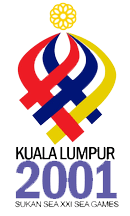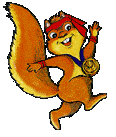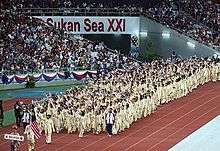2001 Southeast Asian Games
 | |||
| Host city | Kuala Lumpur, Malaysia | ||
|---|---|---|---|
| Nations participating | 10 | ||
| Events | 391 in 32 sports | ||
| Opening ceremony | 8 September 2001 | ||
| Closing ceremony | 17 September 2001 | ||
| Officially opened by |
King Salahuddin Yang di-Pertuan Agong | ||
| Officially closed by | Mahathir Mohamad | ||
| Athlete's Oath | Noraseela Mohd Khalid | ||
| Torch lighter | Daud Ibrahim | ||
| Ceremony venue | Bukit Jalil National Stadium | ||
| Website | 2001 Southeast Asian Games | ||
| |||
The 2001 Southeast Asian Games (Malay: Sukan Asia Tenggara 2001), officially known as the 21st Southeast Asian Games, was a multi-sport event held in Kuala Lumpur, Malaysia from 8 to 17 September 2001 with 391 events in 32 sports and disciplines featured in the games. The games were opened by Yang di-Pertuan Agong Sultan Salahuddin Abdul Aziz Shah ibni Almarhum Sultan Hisamuddin Alam Shah Al-Haj (Malaysian King Sultan Salahuddin) in the Bukit Jalil National Stadium and were closed by Prime Minister Dr. Mahathir bin Mohamad.
It was the fifth time Malaysia host the games, and the first time since 1989. Malaysia is the third country to host the games after Thailand and Myanmar and before Singapore, Indonesia, the Philippines and Brunei.
The final medal tally was led by host Malaysia, followed by Thailand and Indonesia. Several games, Asian and national records were broken during the games. With little or no controversies at all, the games were deemed generally successful with the rising standard of competition amongst the Southeast Asian nations.
Organisation

Venues
The 21st Southeast Asian Games had 38 venues for the games. 18 in Kuala Lumpur, 10 in Selangor, 4 in Johor and 3 each in Negeri Sembilan and Penang respectively.
Torch relay
The 21st SEA Games torch relay ran from 10 March 2001 to 8 September 2001, covering a distance of 7,884 km. The run began in Labuan followed by Sabah and Sarawak. In the peninsular, it started in Langkawi and passed through 12 states before it ended in Kuala Lumpur. The last leg of the run covered approximately 15 km, from Merdeka Square to Bukit Jalil National Stadium.[1]
Marketing
Logo and mascot

The logo of the 2001 Southeast Asian Games is an image of a flame, a universal symbol of passion and excellence. It is frequently used in most international sports. In stylising the "Flame" for the logo, usage of the tongues of flame have been individually separated and simplified. This "ribbon" effect allows flexibility in manipulation. The weaving formation conveys unity, a coming together of Southeast Asia's best athletes. The weaving also gives an opportunity to form the Roman numeral XXI to represent the 21st SEA Games. Colours of the national flag are used to establish national identity. The flame tip is the logo of the Southeast Asian Games Federation.[2]
The official mascot of the 2001 Southeast Asian Games is a squirrel named Si Tumas, short form for Tupai Emas (Golden squirrel). It is said the Squirrel is a lovable creature found almost everywhere in the world. In folk tales of many countries, the squirrel is depicted as a friendly and fun animal known for its high energy and speed of motion. The adoption of the squirrel as the games mascot is to borrow its pleasant, friendly fun characteristics to add life to the event. The gold colouring on the squirrel enhances the winning aspect. The SI is phonetically similar to Sea as in SEA GAMES. The SI is also a friendly form of address in Malay. TU is the first part of Tupai which means squirrel in Malay and MAS comes from the word EMAS which is Malay for gold.[3]
Songs
The theme song of the games is "In Glory We Celebrate (The SEA Games - 2001)", composed by Helen Yap from Magic Nova Productions with lyrics written in English by Tom Leng and lyrics written in Malay by Loloq, and was sung by Lynn Ali.[4][5][6] A campaign song of the games was composed by Jaafar Abdul Rahman Idris with lyrics written by Dato Mokhzani Ismail and was sung by Adibah Noor.[7]
The games
Opening ceremony

More than 15,000 volunteers which include 7,000 school children involved in the opening ceremonies, and to create history by organizing the first SEA Games in three cities. Parallel ceremonies at the Larkin Stadium in Johor Baru and the Penang International Sports Arena made the first SEA Games of the new millennium a most memorable event.
As the fireworks lit the sky at the Bukit Jalil National Stadium, more than 50,000 people cheered and rejoiced in celebration of the day’s golden achievements and to usher in the two-week friendly Games among the 10 competing nations. The enthusiastic crowd and over 5,000 athletes broke into a deafening roar the moment the Yang di Pertuan Agong King Salahuddin proclaimed: “Let the Games begin”, giving the cue for a 10-gun salute. There was an almost endless round of cheers and applause at the National Stadium throughout the four-hour Games opening extravaganza. Excitement took all forms, such as paratroopers sailing in from the clear sky, carrying the national flags of the 10 countries of the SEA Games fraternity.[8]
Malaysia's fourth Prime Minister Dr. Mahathir Mohamad and his wife Dr. Siti Hasmah, riding in an open top army 4WD, waving to the crowd and were given a rousing and enthusiastic reception by the spectators. The choir, which rendered the patriotic songs, kicked off a chain of performances including formations, songs and dances. The highlight of the event was the marching-in of the national contingents comprising some 5,000 sportsmen and sportswomen from all over Southeast Asia. They were led by Games mascot Si Tumas.
As each contingent entered the stadium, the giant electronic scoreboard flashed welcome greetings in their national language, such as Minga la bar (for the Myanmar team) and Mabuhay (for the team from the Philippines). The Singapore contingent marched in with two banners which read 'Team Singapore mengucapkan tahniah kepada Malaysia atas kejayaan menganjurkan Sukan SEA ke-21' (Team Singapore congratulated Malaysia on the success of hosting the 21st SEA Games).[9] The loudest cheers were for the home team, with flag bearer Nur Herman Majid leading the nation’s 558 athletes amid the ecstatic welcome by fans waving the Malaysia's flag, Jalur Gemilang. The Games torch was brought into the stadium by former national soccer star Soh Chin Aun and former Philippines track queen Maria Lydia D’Vega Mercado, who then passed it to 19 other runners before the final lap was taken by former cycling ace Daud Ibrahim. From the stage, he held the flaming torch to light a wire leading to the main cauldron at the opposite end of the stadium. As it lit up, thousands of balloons and confetti poured over the spectators amid more cheers and applause. This signaled a jubilant start to the biggest biennial sports meet in the culturally-rich Southeast Asian region.[10]
Participating nations
|
|
|
Sports
|
|
|
Calendar
| OC | Opening ceremony | ● | Event competitions | 1 | Gold medals | CC | Closing ceremony |
| September | 1 Sat |
2 Sun |
3 Mon |
4 Tue |
5 Wed |
6 Thu |
7 Fri |
8 Sat |
9 Sun |
10 Mon |
11 Tue |
12 Wed |
13 Thu |
14 Fri |
15 Sat |
16 Sun |
17 Mon |
Gold medals |
|---|---|---|---|---|---|---|---|---|---|---|---|---|---|---|---|---|---|---|
| Ceremonies | OC | CC | ||||||||||||||||
| ● | ● | 2 | 2 | 4 | ||||||||||||||
| 10 | 12 | 12 | 12 | 46 | ||||||||||||||
| ● | ● | 2 | ● | ● | ● | 5 | 7 | |||||||||||
| ● | ● | ● | ● | ● | ● | ● | 2 | 2 | ||||||||||
| 2 | 1 | 1 | 2 | 1 | 1 | 1 | 1 | 10 | ||||||||||
| 2 | 2 | 2 | 2 | ● | 4 | 12 | ||||||||||||
| ● | ● | ● | ● | ● | 11 | 11 | ||||||||||||
| 2 | 4 | 6 | 2 | ● | 2 | 2 | 2 | 20 | ||||||||||
| 4 | 4 | 8 | ||||||||||||||||
| 1 | ● | 1 | 1 | 1 | 1 | ● | ● | 2 | 7 | |||||||||
| 2 | 2 | 1 | 5 | |||||||||||||||
| ● | ● | ● | ● | ● | 1 | 1 | 2 | |||||||||||
| ● | ● | ● | ● | ● | ● | ● | ● | ● | ● | ● | ● | 1 | 1 | 2 | ||||
| ● | ● | ● | 2 | ● | 2 | 4 | ||||||||||||
| 2 | 2 | ● | 10 | ● | ● | 6 | 20 | |||||||||||
| 5 | 5 | 4 | 14 | |||||||||||||||
| 6 | 7 | 6 | 19 | |||||||||||||||
| ● | ● | ● | 2 | 4 | 6 | |||||||||||||
| ● | ● | ● | 1 | 1 | ||||||||||||||
| ● | 3 | 8 | 10 | 21 | ||||||||||||||
| 2 | ● | 2 | 2 | 6 | ||||||||||||||
| ● | 4 | ● | 4 | 8 | ||||||||||||||
| 1 | 4 | ● | 4 | ● | 4 | 13 | ||||||||||||
| ● | ● | ● | 1 | ● | ● | 2 | 3 | |||||||||||
| 10 | 4 | 4 | 4 | 4 | 4 | 6 | 36 | |||||||||||
| ● | ● | 2 | ● | ● | 2 | 4 | ||||||||||||
| 6 | 7 | 6 | 6 | 7 | 32 | |||||||||||||
| 1 | 1 | 2 | ||||||||||||||||
| ● | ● | 2 | ● | 2 | 1 | 2 | 7 | |||||||||||
| 7 | 5 | 4 | 16 | |||||||||||||||
| ● | ● | ● | 2 | ● | 2 | 3 | 7 | |||||||||||
| ● | ● | ● | ● | ● | ● | ● | 2 | 2 | ||||||||||
| ● | ● | ● | ● | 1 | 1 | |||||||||||||
| 3 | 3 | 3 | 4 | 13 | ||||||||||||||
| ● | ● | 20 | 20 | |||||||||||||||
| Total gold medals | 0 | 0 | 0 | 0 | 0 | 0 | 0 | 13 | 30 | 37 | 63 | 55 | 48 | 53 | 52 | 37 | 3 | 391 |
| Cumulative total | 0 | 0 | 0 | 0 | 0 | 0 | 0 | 13 | 43 | 80 | 143 | 198 | 246 | 299 | 351 | 388 | 391 | |
| September | 1 Sat |
2 Sun |
3 Mon |
4 Tue |
5 Wed |
6 Thu |
7 Fri |
8 Sat |
9 Sun |
10 Mon |
11 Tue |
12 Wed |
13 Thu |
14 Fri |
15 Sat |
16 Sun |
17 Mon |
Gold medals |
Medal table
A total of 1280 medals comprising 392 gold medals, 390 silver medals and 498 bronze medals were awarded to athletes. The Host Malaysia's performance was their best ever yet in Southeast Asian Games History and emerged as overall champion of the games.[11]
- Key
* Host nation (Malaysia)
| Rank | NOC | Gold | Silver | Bronze | Total |
|---|---|---|---|---|---|
| 1 | 111 | 75 | 85 | 271 | |
| 2 | 103 | 86 | 89 | 278 | |
| 3 | 72 | 74 | 80 | 226 | |
| 4 | 33 | 35 | 64 | 132 | |
| 5 | 30 | 66 | 67 | 163 | |
| 6 | 22 | 31 | 42 | 95 | |
| 7 | 19 | 14 | 53 | 86 | |
| 8 | 1 | 3 | 7 | 11 | |
| 9 | 1 | 1 | 5 | 7 | |
| 10 | 0 | 5 | 6 | 11 | |
| Total (10 NOCs) | 392 | 390 | 498 | 1280 | |
See also
References
- ↑ "SEA Games torch passes through Klang Valley". New Straits Times. 24 August 2001. Retrieved 2 February 2016.
- ↑ "Logo at the Official Website of the Games". 7 December 2001. Archived from the original on 7 December 2001. Retrieved 29 January 2016.
- ↑ "Mascot at the Official Website of the Games". 7 December 2001. Archived from the original on 7 December 2001. Retrieved 29 January 2016.
- ↑ "Lagu tema Sukan SEA dilancar". 1 June 2001. Retrieved 8 April 2016.
- ↑ "Theme Song at the Official Website of the Games". 7 December 2001. Archived from the original on 11 December 2001. Retrieved 29 January 2016.
- ↑ "Theme Song at the Official Website of the Games Malay Version". 7 December 2001. Archived from the original on 23 November 2001. Retrieved 29 January 2016.
- ↑ "Campaign Song at the Official Website of the Games Malay Version". 7 December 2001. Archived from the original on 23 November 2001. Retrieved 29 January 2016.
- ↑ "Sukan SEA Alaf Baru Bermula Penuh Gilang-Gemilang" (PDF). Bernama. 8 September 2001. Retrieved 7 May 2016.
- ↑ "ASEAN solidarity prevails despite trying conditions". New Straits Times. Kuala Lumpur. 9 September 2001. Retrieved 2 February 2016.
- ↑ http://properties.d-choice.com/traditionaloffice/sportcomp.htm
- ↑ "Official Medal Tally of the games". Official Website. 3 December 2001. Archived from the original on 3 December 2001. Retrieved 4 February 2016.
External links
- "2001 Southeast Asian Games Official Website". Archived from the original on 7 December 2001.
- Unofficial games site
| Preceded by 1999 Bandar Seri Begawan, Brunei Darussalam |
Southeast Asian Games | Succeeded by 2003 Hanoi and Ho Chi Minh City, Vietnam |